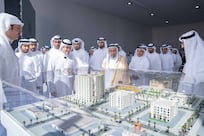Global container traffic is picking up, suggesting world trade could be staging a recovery from last year's recession. DP World, Dubai's ports management company that is the world's fourth largest, saw volumes rise by 16 per cent at 50 terminals to 23.7 million containers. The company suffered an 8 per cent decline last year.
"Some shipping lines announced record profits and some ports reported record volumes," said Mohammed Sharaf, the chief executive of DP World. "If we continue at the same level as the first half of 2010, it's going to be something historical." DP World's recovery owes much to its holdings across Asia, which saw the strongest growth. Container volumes in the Asia-Pacific and Indian subcontinent rose by 22 per cent. UAE operations, in Fujairah, Abu Dhabi and Dubai, grew by a modest 3 per cent.
"Volume growth across our portfolio is largely driven by terminals in Asia, which are primarily reported as joint ventures and associates, in Australia, where volumes are well ahead of 2008 levels, and the recovery of some volumes across European ports," the company said. The recovery in global container traffic reflects increased demand for industrial and manufactured products that make up the bulk of container goods.
DP World's rise follows other economic indicators painting a promising picture for global trade. Air cargo, which accounts for a third of global trade by value, is up 30 per cent for the first five months of the year compared with the same period last year, the International Air Transport Association says. The strongest rebounds are being seen in Latin America and Africa, which both grew by 60 per cent in May alone.
With Europe suffering from government spending cuts and the US experiencing slower growth, economists say Asia is expected to become the dominant axis for the global economy over the next decade. "We think the crisis of 2008 and 2009 was when you saw the start of a tipping point when the balance of global consumption and production and global asset ownership shifted from West to the East," said Simon Williams, the chief economist at HSBC Middle East.
"This will be a dominant theme for the next decade and beyond." But Mr Sharaf added a note of caution. In a conference call to investors, he cast doubt on whether current growth rates could be sustained in the second half of the year. "Many who saw the growth in trade in the first half of 2010 ask 'is it real or artificial growth'?" Mr Sharaf said. "Some say it was real while others say the market will soften in the second half of the year."
He said he expected more moderate growth in the second half. "I hope we continue at the same levels of growth but it probably will not be as fast as what we have seen so far," Mr Sharaf said. DP World has extended its push into emerging markets this year with a development in Callao, Peru, opening and two more ports on the subcontinent due to open by the end of the year. They are Vallarpadam in India and Karachi in Pakistan.
igale@thenational.ae





